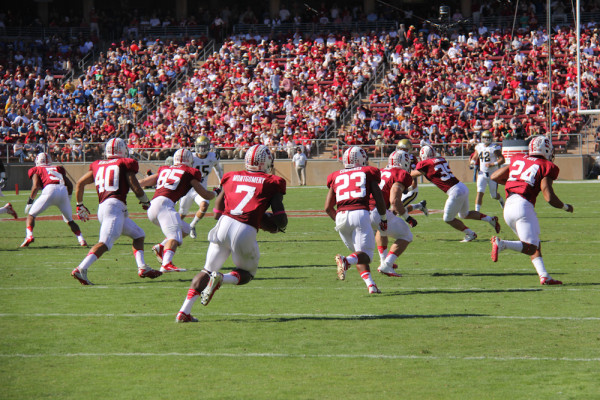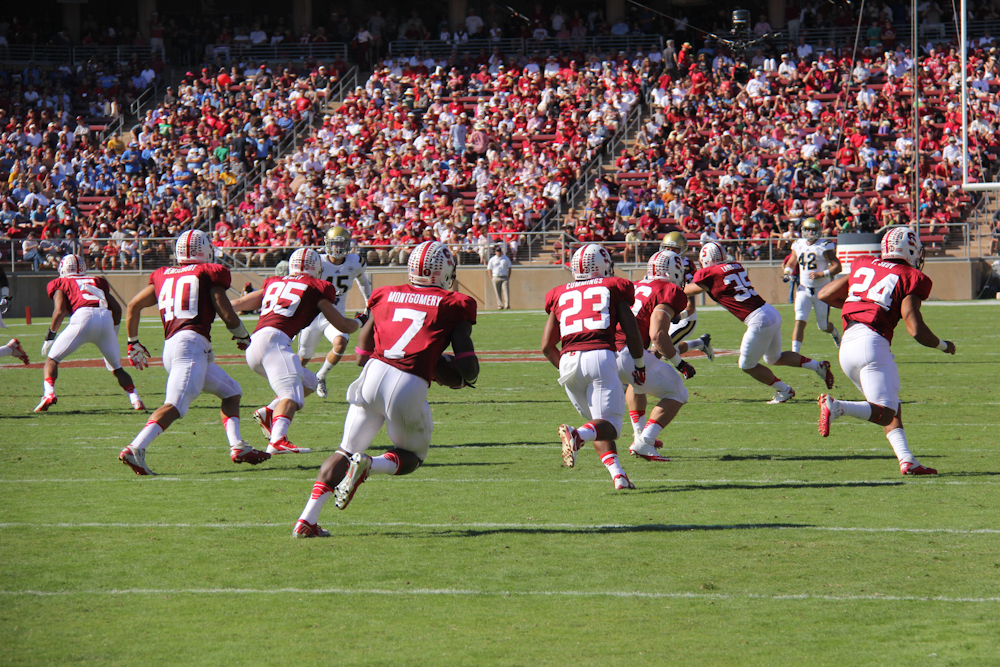Most of Oregon’s opponents are concerned primarily with stopping the Ducks’ quick-strike offensive attack, which ranks second in the nation in points (55.6) and yards (632.1) per game. But Oregon also fields one of the nation’s best defenses, including an elite secondary that could give junior quarterback Kevin Hogan, who has looked shaky at times this season, a lot of trouble. We asked football writers Winston Shi, Do-Hyoung Park and David Cohn: Which element of the Ducks’ game is most likely to doom the Cardinal on Thursday?

Winston: I think the question says it all — Stanford’s offense is going to have to do its part to win the game on Saturday.
Quite frankly, Stanford should never be expected to totally shut down the Oregon offense. But with 80-90 yards of field between the Ducks and the end zone at the start of each and every drive, Stanford can definitely slow Oregon down. Considering nothing else, holding the Ducks to 20 points (28 at the absolute most) should be enough for Stanford to have a chance to win. Last game, UCLA held Oregon to 14 points through three quarters.
That begs the question: Can Stanford’s suddenly sputtering offense score 20 points of its own? Outside of garbage time, the Ducks have only given up more than 20 points in one game — Washington. Of course, Stanford head coach David Shaw said after 2012 Oregon that the Cardinal should have beaten Oregon by more, and I agree. Reviewing that game, Oregon gave Stanford a lot of chances that the Cardinal did not convert. Receivers got open and the Oregon run defense wasn’t brilliant, yet Stanford nearly killed itself with turnovers. Last year, Stanford actually had more yards than Oregon, and excluding Oregon quarterback Marcus Mariota’s big scramble, yardage wasn’t even a contest.
The sky is not falling on Stanford’s offense, and X’s and O’s wise, it looks like Stanford is getting ready to throw the kitchen sink at Oregon. But among three solid units, the Stanford offense has produced by far the most evidence that it will be the one to fail. I hope it proves me wrong.
Do: I’d just like to say that “doom” is a very strong word. If the Ducks are going to beat the Cardinal on Thursday, it will certainly not be because of a specific element of their game. It will take a solid all-around element from the entire Ducks team, from Mariota to the defense to maybe even oft-beleaguered kicker Alejandro Maldonado (we love you, Alejandro!) to sink Stanford’s ship.
That being said, I’m going to build off the prompt and say that the Ducks’ secondary — led by the always-threatening cornerback Ifo Ekpre-Olomu — is going to be a significant factor in how this game goes. Stanford’s passing attack, especially given its recent struggles, is definitely not the best that Oregon’s secondary will have faced this year. Looking at the numbers, however, it seems at first glance that Oregon’s pass defense has been above average but not excellent, having allowed 228 yards per game through the air.
However, looking closer, Oregon’s pass defense seems dominant. For one, teams love to pass against the Oregon defense. Opponents have attempted 344 passes against the Ducks — good for third in the nation behind just Missouri and Stanford. The big difference is that the Ducks’ secondary has only allowed 56 percent of passes to be completed and is second in the nation to Michigan State by allowing just 5.31 yards per attempt. It has also intercepted 13 passes, contributing to an eye-popping plus-12 turnover differential.
This pass defense is battle-tested and ready for much bigger challenges than a recently mediocre Stanford passing offense, whose success is contingent on the effectiveness of the Cardinal’s rush offense as well. If Hogan can’t crack the secondary, Oregon will be able to stack the box against Gaffney, and the Cardinal will be in for a rough night.
David: I agree with Do on this one. I am certainly not prepared to say the Cardinal is going to be doomed by an aspect of the Ducks.
However, I will say that Mariota’s short and intermediate level passing game is most likely to present problems for the Cardinal. Mariota is having another standout season as the Ducks starting quarterback and is, by most estimates, the favorite to win the Heisman Trophy simply because his game really has no significant flaws. Mariota is fabulous at moving through his progressions in an efficient and timely manner, while his accuracy and incredible speed when running the football make him an absolute nightmare to contain for most defenses.
Stanford, unlike most of Mariota’s opponents, has an extremely talented defense that is more than capable of preventing Mariota — or just about any quarterback in the country, for that matter — from lighting up the scoreboard with big plays. However, the Cardinal has struggled this year defending the short-passing game and bubble screens of its opponents, a flaw that Mariota and Oregon will look to exploit.
In Oregon’s most recent game against UCLA, Mariota completed just one pass for more than 25 yards; instead, he dissected the Bruin defense with nine completions between 10 and 20 yards and seven additional passes going for seven to 10 yards. Coupling that success with the frenetic pace of the Quack Attack was enough to wear down the Bruin defense by the fourth quarter. If the Cardinal defense is unable to fight through blocks on the bubble screens or get off the field early in the contest, Stanford will suffer a similar fate to UCLA as well as the 2011 Cardinal counterpart.
Winston Shi and David Cohn are secretly Roxy Sass while Do-Hyoung Park is getting screwed over by actually taking Roxy Sass’s advice. Give alternative ideas to Winston, David and Do at wshi94 ‘at’ stanford.edu, dmcohn ‘at’ stanford.edu and dpark027 ‘at’ stanford.edu.
